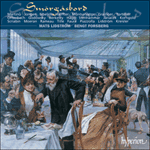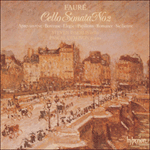Following the publication by Julien Hamelle of the
Élégie, Fauré was immediately commissioned to write a second piece for cello, perhaps as a lighter counterpart. But again there was a delay in publication, this time of fourteen years until 1898. On this occasion some responsibility might lie with the increasingly sour relations between composer and publisher, whose incompetence extended to actually losing manuscripts and who insisted on calling the piece first
Libellules (Dragonflies), then
Papillon (Butterfly); to which Fauré, no lover of fancy titles, retorted: ‘Butterfly or Dung Fly, call it whatever you like.’ The five sections of
Papillon contain contrasting material: the odd-numbered ones might equally be a French ‘Flight of the Bumblebee’, pre-empting Rimsky-Korsakov’s 1899 version; in the two enclosed sections the cello sings a lyrical, symmetrical song that finally takes wing over one of Fauré’s favourite descending bass lines.
from notes by Roger Nichols © 2012
Après la publication par Julien Hamelle de l'
Élégie, Fauré a immédiatement reçu la commande d’une seconde œuvre pour violoncelle, peut-être comme contrepartie plus légère. Mais, à nouveau, il y a eu du retard, quatorze ans cette fois jusqu’en 1898. Dans le cas présent, une part de la responsabilité tient peut-être aux relations de plus en plus acerbes entre le compositeur et l’éditeur, qui a poussé l’incompétence jusqu’à la perte totale de manuscrits et qui a insisté pour appeler la pièce d’abord
Libellules, puis
Papillon; ce à quoi Fauré, qui n’aimait pas les titres fantaisistes, rétorqua: «Papillon ou Mouche à merde, mettez ce que vous voulez.» Les cinq sections de
Papillon contiennent du matériel contrasté: les numéros impairs pourraient tout aussi bien être un «Vol du bourdon» français, anticipant celui que Rimski-Korsakov composera en 1899; dans les deux sections encastrées, le violoncelle chante une mélodie lyrique symétrique qui s’envole finalement sur l’une des basses descendantes favorites de Fauré.
extrait des notes rédigées par Roger Nichols © 2012
Français: Marie-Stella Pâris
Nachdem die Élégie von Julien Hamelle publiziert worden war, erhielt Fauré sofort den Auftrag, ein zweites Stück für Cello zu schreiben, möglicherweise als ein leichteres Pendant. Doch auch hier trat eine Verzögerung ein, diesmal jedoch von 14 Jahren, bis 1898. Diesmal mag der Grund dafür die zunehmend verbitterte Beziehung zwischen Komponist und Herausgeber gewesen sein—letzterer war derart inkompetent, dass ihm mehrere Manuskripte abhandenkamen. Zudem bestand er zunächst darauf, das Stück
Libellules [Libellen], dann
Papillon [Schmetterling] zu nennen, woraufhin Fauré, der modische Titel nicht mochte, erwiderte: „Schmetterling oder Mistfliege, nennen Sie es, wie Sie wollen.“ In den fünf Teilen von
Papillon findet sich unterschiedliches Material: die Abschnitte mit den ungeraden Zahlen könnten ebenso gut ein französischer „Hummelflug“ sein und damit das Werk Rimsky-Korsakow von 1899 vorwegnehmen. In den beiden umrahmten Teilen singt das Cello ein lyrisches, symmetrisches Lied, das schließlich über einer von Fauré besonders geschätzten absteigenden Basslinie hinwegfliegt.
aus dem Begleittext von Roger Nichols © 2012
Deutsch: Viola Scheffel


 Smörgasbord
Smörgasbord Fauré: Cello Sonata No 2 & other works
Fauré: Cello Sonata No 2 & other works
